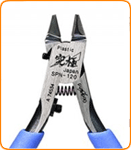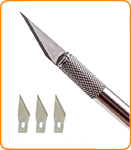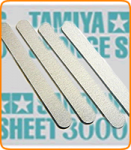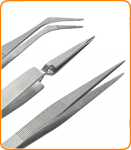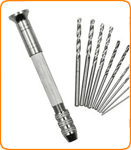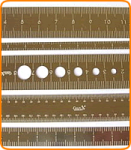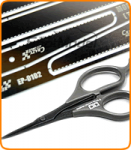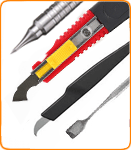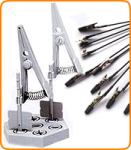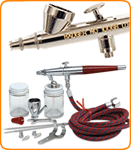Hasegawa 10710 1/200 ANA Boeing 777-300
The B777 is the world's largest twin-engine passenger aircraft.
Its size is close to that of the B747, and the engines it is equipped with are Pratt & Poitney PW4000, General Electric GE90, and Rolls-Royce Trent 800, which have a thrust of 34,000kg to 38,000kg, and the thickness of the engines is comparable to that of the B737 fuselage.
It is also the first Boeing passenger aircraft to adopt digital fly-by-wire.
However, unlike Airbus aircraft, the cockpit still has a control wheel like conventional aircraft, and this difference is also reflected in the approach to protecting the airspace. On Airbus aircraft, the pilot's operation is canceled if he attempts to exceed the airspace, whereas on the B777, the pilot's operation to exceed the airspace is canceled by a warning such as the control wheel becoming heavy, but if ignored, the pilot can pass through the airspace.
This can be seen as a manifestation of Boeing's intention to respect the pilot's decision.
In addition, the B777 is equipped with the latest avionics, and LCD (liquid crystal display) displays are used instead of the CRT displays used in the B747-400.
The Japanese aviation industry is also involved in the development and production of the aircraft, and more than 20% of the total is produced in Japan. It is also worth noting that the B777 is the first airplane born from the spirit of "Working Together," in which the user airlines work together from the development stage to create a user-friendly airplane . The -300 type extends the -200 fuselage by 5.3m at the front and 4.8m at the rear, making it the longest passenger airplane in the world, with a total length of 73.8m, surpassing the 747 series. With the extension of the fuselage, the engine is also equipped with a type with increased thrust. In addition, small cameras are installed on the leading edges of the left and right horizontal stabilizers and all legs to prevent the wheels from coming off during taxiing. In addition, a retractable tail skid is installed to prevent the rear of the fuselage from rubbing against the ground during takeoff. As a result of its larger size, the Boeing 777-300 can now carry up to 550 passengers (all economy class).
Aircraft data:
Length: 73.8m, Width: 60.9m, Height: 18.5m,
Engine: P&W PW4090, Thrust: 40,900kg x 2, Number of seats: 470
Its size is close to that of the B747, and the engines it is equipped with are Pratt & Poitney PW4000, General Electric GE90, and Rolls-Royce Trent 800, which have a thrust of 34,000kg to 38,000kg, and the thickness of the engines is comparable to that of the B737 fuselage.
It is also the first Boeing passenger aircraft to adopt digital fly-by-wire.
However, unlike Airbus aircraft, the cockpit still has a control wheel like conventional aircraft, and this difference is also reflected in the approach to protecting the airspace. On Airbus aircraft, the pilot's operation is canceled if he attempts to exceed the airspace, whereas on the B777, the pilot's operation to exceed the airspace is canceled by a warning such as the control wheel becoming heavy, but if ignored, the pilot can pass through the airspace.
This can be seen as a manifestation of Boeing's intention to respect the pilot's decision.
In addition, the B777 is equipped with the latest avionics, and LCD (liquid crystal display) displays are used instead of the CRT displays used in the B747-400.
The Japanese aviation industry is also involved in the development and production of the aircraft, and more than 20% of the total is produced in Japan. It is also worth noting that the B777 is the first airplane born from the spirit of "Working Together," in which the user airlines work together from the development stage to create a user-friendly airplane . The -300 type extends the -200 fuselage by 5.3m at the front and 4.8m at the rear, making it the longest passenger airplane in the world, with a total length of 73.8m, surpassing the 747 series. With the extension of the fuselage, the engine is also equipped with a type with increased thrust. In addition, small cameras are installed on the leading edges of the left and right horizontal stabilizers and all legs to prevent the wheels from coming off during taxiing. In addition, a retractable tail skid is installed to prevent the rear of the fuselage from rubbing against the ground during takeoff. As a result of its larger size, the Boeing 777-300 can now carry up to 550 passengers (all economy class).
Aircraft data:
Length: 73.8m, Width: 60.9m, Height: 18.5m,
Engine: P&W PW4090, Thrust: 40,900kg x 2, Number of seats: 470
| General Info | |
| Scale | 1/200 |
| Type | Scale Model Kit |
| Subtype | Civilian Aircraft |
- Stock: Out Of Stock
- Reward Points: 27
- SKU: HA 10710

Hasegawa
MRP: US$21.42 Save: US$3.72
17% OFF
US$17.70
(excl. Tax)
"In-Stock" Really Means It
Combine Shipping & Save
SAME or Next day shipping*
There are no reviews
Maybe you can help? Many users will be grateful to you. And so are we.



